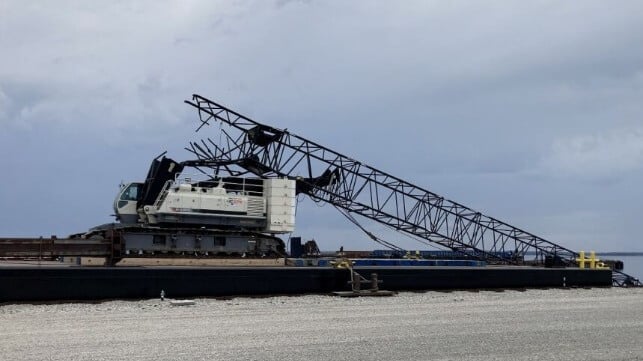NTSB: Ineffective Voyage Planning Caused Towed Crane to Hit Mackinac Bridge

The NTSB report on a 2023 bridge strike says the captain of a tow vessel and barge company managers’ ineffective voyage planning and failure to conduct required checks caused a towed crane to strike the Mackinac Bridge in Michigan. They failed to confirm the air draft and bridge clearance, and the result was $665,000 in damages to the crane as well as $145,000 in damage to the underside of the bridge.
The towing vessel Nickelena (103 feet) was regularly employed to move barges transporting construction equipment to sites around the Great Lakes. In May 2023, they were hired to tow a barge transporting a 160-foot-long boom crane and 5-foot “rooster” sheave on a deck barge from Escanaba to a construction project at Sault Ste. Marine, Michigan. It was a standard assignment, including the fact they would have to transit under the Mackinac Bridge, a roadway suspension bridge that connects the Upper and Lower peninsulas of Michigan.
The crane was secured on the barge on May 6, and the tow commenced. After leaving the port, the captain ordered the tow line increased to 500 feet, and they proceeded. He left the bridge to rest but planned to return before 0200 when they were due to pass under the roadway bridge. The National Oceanic and Atmospheric Administration determined there was no traffic and minimal wind effect at 0200, and the NTSB reports the tow was moving at 8 knots within the marked channel.
The first contact with the bridge was with the stiffening truss below the roadway, at the top of the truss’s bottom chord (about 155 feet above the water). The report indicates given the configuration of the crane, the wires securing the crane boom would have hit first, and then when they parted, the boom would have contacted the top of the chord. As the barge continued forward, the boom would have been pushed backward, and its angle and height above the water would have increased, leading to damage higher up on the bridge. At some point, the boom contacted the upper diagonal truss, about 183 feet above the water, before folding back and collapsing on the barge.
The engineer aboard the tow vessel was on deck while there was a crewmember at the helm. They did not report hearing the contact, but said when they looked aft, they noticed they could not see the crane’s boom.
The investigation showed that the captain and the managers of the barge company did not attempt to verify bridge clearance and instead accepted the word of the managers supervising the loading of the crane, who told the captain, “Everything’s secured, ready to go.”
The NTSB determined the managers made a visual evaluation that the angle of the crane boom was between 50 and 60 degrees, and the boom was 140 feet. The Load Moment Indicator on the crane was not working, so they relied on their judgment. They decided against lowering the boom to decrease the angle because they thought it would reduce the stability of the barge.
Towing vessel operators are required to have a towing safety management system (TSMS), and voyage planning would have been part of the process. The company operating the vessel, Basic Towing, told investigators they had a TSMS, but the NTSB says no documentation was found that a navigation assessment was conducted and no attempt by the captain to verify the tow was safe for the intended route.
The water under the bridge was higher than average, with clearance at about 153 feet instead of the normal 160 feet. However, it did not matter because the analysis showed the boom was at approximately 62 degrees, which equated to a height of 162.3 feet. The report says the boom needed to be at about 55 degrees to pass under the bridge at the center of the channel. The visual evaluation also underestimated the length of the boom by 20 feet. The NTSB reports the boom was 10 feet too high for clearance.
The erroneous estimates provided by the managers set off the chain of events. However, the captain, who was responsible for ensuring the safety of the transit, did not confirm the boom height, nor was there an attempt to verify the bridge’s vertical clearance.
